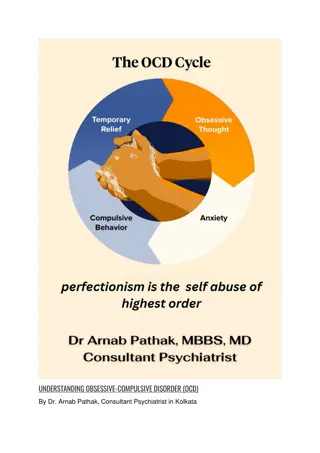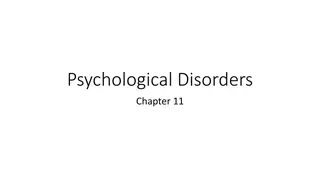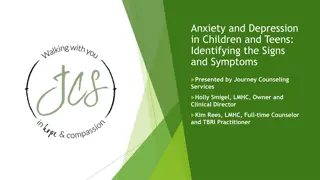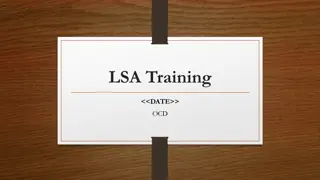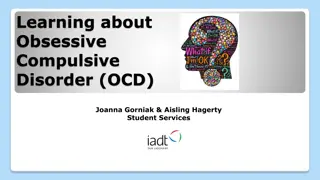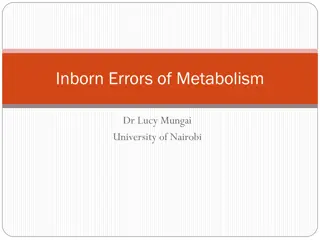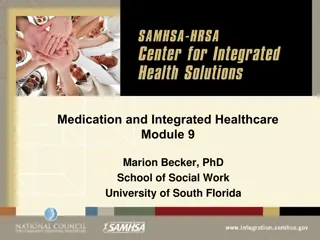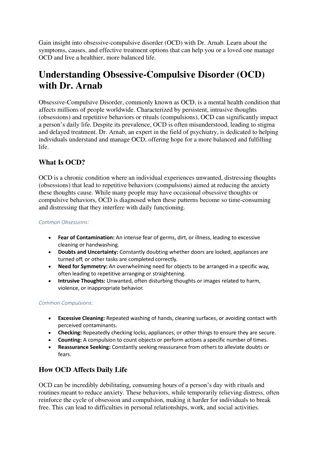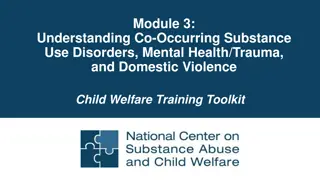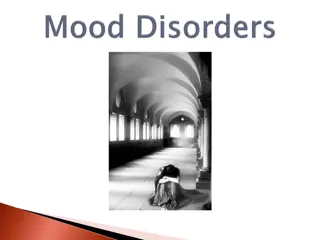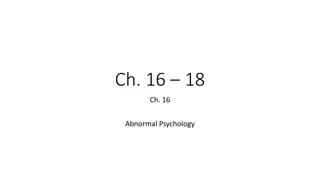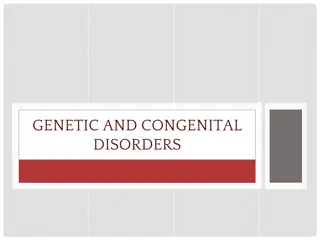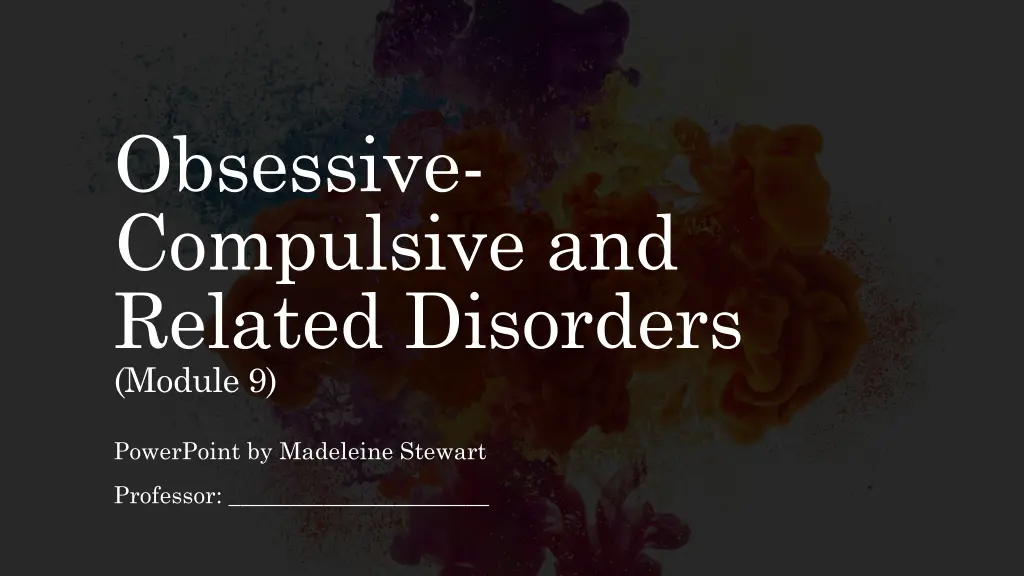
Understanding Obsessive-Compulsive Disorders and Related Conditions
Explore the presentation, epidemiology, comorbidity, etiology, and treatment options for Obsessive-Compulsive Disorders (OCD) and Body Dysmorphic Disorder (BDD). Learn about symptoms, prevalence, gender differences, and common treatments like Exposure and Response Prevention. Gain insights into the impact on individuals' functioning and associated comorbidities.
Download Presentation

Please find below an Image/Link to download the presentation.
The content on the website is provided AS IS for your information and personal use only. It may not be sold, licensed, or shared on other websites without obtaining consent from the author. If you encounter any issues during the download, it is possible that the publisher has removed the file from their server.
You are allowed to download the files provided on this website for personal or commercial use, subject to the condition that they are used lawfully. All files are the property of their respective owners.
The content on the website is provided AS IS for your information and personal use only. It may not be sold, licensed, or shared on other websites without obtaining consent from the author.
E N D
Presentation Transcript
Obsessive- Compulsive and Related Disorders (Module 9) PowerPoint by Madeleine Stewart Professor: ______________________
Learning Objectives Describe how obsessive-compulsive disorders present. Describe the epidemiology of obsessive-compulsive disorders. Describe comorbidity in relation to obsessive-compulsive disorders. Describe the etiology of obsessive-compulsive disorders. Describe treatment options for obsessive-compulsive disorders.
Obsessive-Compulsive Disorder (OCD) OCD presents with obsessions and/or compulsions that significantly impair one s functioning. Obsessions intrusive, time-consuming, unwanted, repetitive, and persistent thoughts, urges, or images (e.g., contamination, errors of uncertainty, thoughts of physical harm or violence, orderliness) Compulsions repetitive behaviors or mental acts that an individual performs in order to alleviate the anxiety caused by an obsession (e.g., checking, counting, hand-washing, symmetry, repeating specific words) Also, 41% will be diagnosed with a major depressive episode. Childhood triad: OCD, tic disorder, ADHD Those with schizophrenia, bipolar disorder, and Tourette s have a higher chance of having OCD. High comorbidity (76%) with other anxiety disorders. Prevalence in the United States and worldwide is 1.2%. More common in women than men except in childhood; genders tend to differ in how their OCD presents
OCD: In Action, DSM-5 Criteria In the video, what obsession(s) and compulsion(s) does the man report?
Treatments 1. Exposure and Response Prevention First developed by Victor Meyer in 1966 Individuals are repeatedly exposed to their obsession while simultaneously being prevented from engaging in their compulsive behaviors. Involves teaching the patient relaxation techniques Works with a hierarchy of obsessions 86% response rate Biggest obstacle is committing to treatment exposure is stressful! 2. Psychopharmacology Only a temporary fix 60% experienced improvement, but symptoms quickly returned after discontinuation of medicine. There s no added benefit of a combination treatment.
Body Dysmorphic Disorder (BDD) Obsessions focus on perceived flaws or defects in one s physical appearance that are not visible to others (e.g., skin, hair, nose) e.g., muscle dysmorphia Compulsions involve comparing one s body to others , repeatedly looking at one s reflection, excessive grooming Individuals spend an average of 3 to 8 hours a day on their compulsions which causes significant impairment in functioning. Prevalence rate in the United States is 2.4% although the worldwide rate is 1.7- 1.8%. Women are more likely to be diagnosed with BDD than men; gender-specific presentations Mostly comorbid with major depressive disorders Somewhat comorbid with social anxiety, OCD, substance-related disorders Comorbidity
BDD: In Action, DSM-5 Criteria Why do you think the first doctor from the video missed the patient s final diagnosis of BDD?
Same as OCD Difficult, because only 9% of participants experienced full remissions at their 1-year follow-up Treatments 21% reported full remission at the same follow-up Another study showed 76% had full remission over an 8-year period Plastic surgery and medical treatments 76.4% reported engaging in this in some way Individuals are rarely satisfied afterwards
Hoarding Persistent over- accumulation of possessions without ever discarding possessions, regardless of their value or sentiment Possessions are often kept in living spaces, leaving these spaces unusable Cleaning causes significant distress Cognitively, individuals fear losing important information and/or being wasteful. Prevalence (although unstudied) is about 2-6% Impacts daily functioning More common in males than females according to some studies, but vice versa in other studies; females seek treatment more than males Older individuals (ages 55-94) are 3 times more likely to be diagnosed than younger individuals High comorbidity with mood and anxiety disorders (75%) while about 20% also have OCD
Treatments CBT (discussions about the individual s motives for keeping items and their fears about cleaning) Many individuals prematurely end treatment.
Etiology Biological Hereditary transmission Twin studies Stronger heritability association for obsessions than for compulsions Earlier onset correlates with more first-degree relatives diagnosed with OCD Neurotransmitter deficits (serotonin and possibly glutamate, GABA, and dopamine) Abnormal functioning in brain structures (orbitofrontal cortex, caudate nuclei, and thalamus) Cognitive Over-interpretation of potential negative outcomes of events Disconfirmatory bias (causes the individual to seek out evidence that proves they failed to perform the ritual or compensatory correctly) Can t trust themselves and their instincts Behavioral (classical conditioning)

